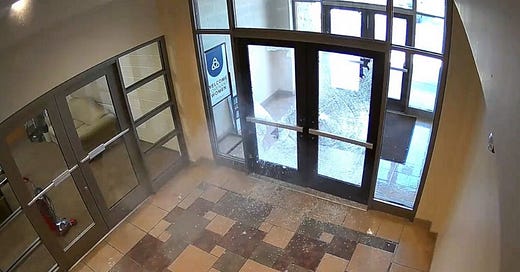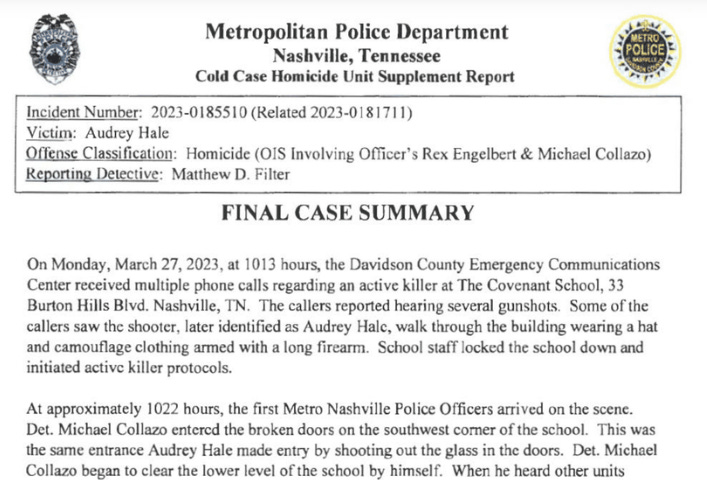New Questions One Year After Covenant School shooting in Nashville
Information uncovered by WSMV4--based on my analysis of body cam footage--raises even more questions about the police response to a school shooting.
My questions resulted in the Nashville Police Department changing their public timeline and statements about the police response to The Covenant School shooting one year ago.
After reading my Substack article—11 months later: Nashville police response to Covenant School shooting remains secret, leaving lessons unlearned—Jeremy Finley and WSMV-4 Investigates (Nashville) took my questions to the Nashville Police Department.
I posed these questions in February:
Why hasn’t an official timeline been released that details when each officer arrived at the school?
Did patrol officers wait outside until tactical officers arrived?
If patrol officers were not at the school within 2-3 minutes, what delayed their response?
My questions prompted new details to be released by the Nashville Police Department, but this new information prompts the need for even more examination into exactly what happened.
New timeline
According to time stamps reviewed by Nashville Metro police for WSMV4 Investigates, Detective Collazo (armed only with a handgun) was the first officer to arrive and made entry at the school through the broken glass doors at 10:22am, 9 minutes after the first 911 call for the school shooting (note: it’s unclear exactly when the first shots were fired and how much time passed between the shooting starting and the first police dispatch). Detective Collazo’s entry into the school is two minutes earlier than the timeline Nashville police have cited for the last year.
At 10:23am, Officer Englebert gained entry to the school at a different location (he is shown unlocking the door in the originally released body camera footage) and led other officers into the school (Office Englebert yells “3 on me” and motions to officer outside to follow him into the building).
After encountering a locked door inside the other side of the building, Detective Collazo (who was the first officer to enter) later joins up with Officer Englebert and they fatally shoot the attacker 14 minutes after the first 911 call.
From the WSMV investigation:
David Riedman, a researcher who developed the K-12 school shooter database that examines every school shooting in the nation, raised questions in a Substack in February about the transparency of Metro police’s response to the shooting.
In the article, “11 months later: Nashville police response to Covenant School shooting remains secret, leaving lessons unlearned,” Riedman writes Metro police’s lack of transparency raises questions.
A year after the shooting, the department has not released an after-action report of their response to the shooting, their investigative files and the writings of the shooter remain tied up in ongoing litigation.
Riedman told WSMV4 Investigates that he’d like transparency about how quickly police responded to the shooting.
“The question that’s about broader accountability, and broader procedure, are if the closest officer or the first officers that were there went in immediately or waited. That’s an important theme,” Riedman said.
The only body camera video that has been released so far is an edited version without timestamps that shows Officer Englebert arriving, unlocking the door, and searching for the shooter. New video shows Detective Collazo responding, but not video from him entering the building for the first time. WSMV4 Investigates has asked for all the video, including the moments Collazo arrived, but the full investigative file has not yet been released.
This new timeline and information about a detective entering the school first raises a new set of questions:
How did a detective—who was 9 minutes away from the campus—arrive before any of the patrol officers assigned to that area?
What is the timeline of when the first patrol officers arrived?
Statement from Nashville police confirm that Officer Engelbert directed other officers to follow him inside the schools. Why were these patrol officers waiting outside from a more experience and tactically trained officer to direct (this goes against active shooter training to find the assailant immediately)?
Another important detail is the first arriving detective entered the school with only a handgun. Does the Nashville Police Department issue every officer the equipment needed (e.g., rifle, shield, go-bag with tourniquets) in the event that detectives or other “plain clothes” officers are the first to arrive to an active shooter incident?
The report also shows that "officers were searching room by room". Standard training for police responding to a school shooting is to move rapidly toward victims or the sound of gunshots instead of methodically clearing each classroom. A SWAT team that is raiding a drug house would take time to carefully search each room. When there is an active shooter, time is the highest priority.
Did officers searching the school room by room contribute to why it took 14 minutes from the first 911 call for police to locate and kill the shooter?
Lockdown for 14 minutes?
The 14 minute timeline is critical for school officials to think about. I would suggesting taking out your iPhone and setting a timer for 14 minutes just to see how long that amount of time feels. Students and staff are told during lockdown training that they only need to hide for a few minutes until police arrive. Waiting for fourteen minutes is the duration of a full episode of SpongeBob.
Will students be safe hiding inside a classroom for 14 minutes while a shooter is inside the building?
Will critically wounded victims be able to survive for 14 minutes or should teachers/students make every effort to get wounded victims outside for EMS care?
Still the same conclusion
If the first arriving patrol officers in Nashville were unwilling or unable to enter the school before more experienced officers with tactical training arrived, this is a trend that needs to be addressed. Multiple patrol officers stayed outside in Parkland, staged in the hallways at Sante Fe High, and stayed in the hallways and outside the building at Robb Elementary
With safety issues, the public demands information and accountability. When the door blows open on a Boeing 737-MAX jet, the planes get grounded, a report is published, the CEO and top executives have resigned, and we know exactly what happened—and how the problems will be fixed.
When kids are slaughtered inside a school, we get very little information and policy, training, or procedural failures are hidden instead of addressed. This is unacceptable.
David Riedman is the creator of the K-12 School Shooting Database and a national expert on school shootings. Listen to my recent interviews on Freakonomics Radio, New England Journal of Medicine, and Iowa Public Radio the day after the Perry High shooting.







